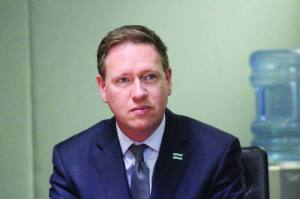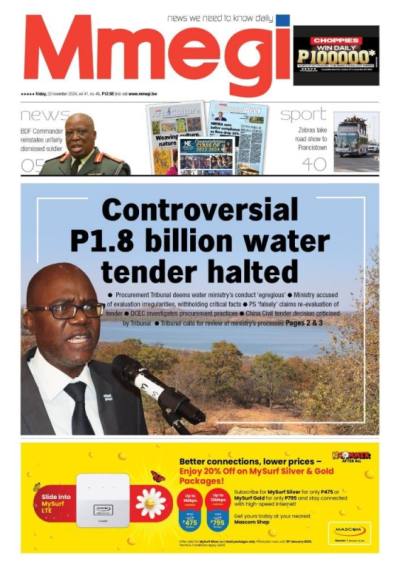The country's national debt rises year-on-year with 2021 closing off at $3.5 billion (approximately P38 billion), a cumulative rise of 0.5 percent from 2020.
This is estimated around the same levels ten years back although it had been brought down over the years as a percentage of the Gross Domestic Product (GDP). Does this development raise any eyebrows?
Many may wonder what has contributed to these significantly high levels of debt and if this is sustainable in the long term. Can the economy survive in the wake of another global recession or global crisis?
Bringing some economic factors into play, as of 2021, GDP stood at approximately P175 billion, which was an 11% growth from the COVID-ridden 2020 as many sectors started recovering, especially diamonds which enhanced the mining sector’s performance. One contributor to GDP is government expenditure, which stood at approximately P65 billion in 2021, essentially 34% of total GDP. The main subsectors were health, education as well as defence, and these have seemed to take the lead across the past year's national budget, but we will get to scrutinise them later.
Now, it is quite unfortunate that when a national budget is formulated, there are instances where we find ourselves to be in a deficit and the 2022 budget shortfall stood at P7bn as announced by Minister of Finance Peggy Serame earlier this year. This is compared to a projected P6bn deficit in the prior financial year and these shortfalls have been rolling year-on-year throughout the National Development Plan (NDP) 11.
In the words of her predecessor, Thapelo Matsheka, while presenting the 2021 budget speech, “we are headed towards an unsustainable fiscal trajectory”, and while COVID-19 was an exceptional circumstance, it is not just a short-term phenomenon but rather reflects a structural problem in that public spending is too high and unaffordable.
The underperformance in our revenue base shows that our expenditure needs to be allocated on an opportunity cost basis. It also demonstrates the need for balancing priorities and this extends to future national budgets as well as fiscal policy amendments such as we saw a couple of months back in response to the rising commodity prices.
The situation leaves so much room to speculate about our readiness to respond to economic shocks in the global economy while our reserves are also slowly declining.
All fair and fine, we are at fiscal crossroads now, and the budget deficit needs to be financed, what happens? The government needs to finance this by borrowing, and in our instance, this is done through the domestic capital markets by issuing bonds, but this will put pressure on domestic interest rates, meaning servicing debt now becomes expensive and may also limit private sector participation, thereby slowing down recovery in financial markets.
The Finance minister’s presentation in February mentioned measures such as expanding the tax revenue base including tax audits and reducing government’s recurrent budget expenditure including the wage bill. The minister also spoke of structural changes to optimise synergies in addition to rebuilding fiscal buffers since the Government Investment account held with the Bank of Botswana had been significantly depleted during the COVID-19 era.
At the end of July 2022, the minister announced a provisional package to offset the impact of higher inflation. The package included the reduction of the Value-Added Tax rate from 14% to 12% for six months, zero-rating cooking oil and petrol for six months as well as an increase in tertiary students allowance by 18.5% including external students. All these unfunded policy changes will cost the government at least P1.8bn, adding more to the deficit as a significant portion also indicates lower revenues for government, which contradicts the intentions presented in February in the budget speech.
Botswana’s sovereign credit rating is currently maintained at 'BBB+/A-2' by Standards & Poors Global Ratings. The stable outlook therein given is based on the performance of the country's diamonds against a downside risk stemming from weakening global economic activity. Bearing this in mind, we previously discussed the energy crisis facing Europe today and the interventions being made by their governments to cushion the cost of living for European citizens and the British who form a customer base for Botswana's diamonds. The United States as well are worried about a looming recession.
Such factors need to paint a downside scenario within our leadership on prudent use of resources and being intentional about our efforts to rebuild our buffers while controlling our debt levels. The former Finance minister of the United Kingdom, George Osborne, has articulated that all financial crises ultimately have their origins in one thing: high public debt.
Many of us are calm that our current debt levels are at 20% of GDP versus the 40% prescribed limit. However, what we should fear is the wake of another global disruption and our country's ability to take on the shock waves and adapt available resource avenues to finance the country's needs.
*Chilo Ketlhoafetse is a Chartered Accountant and seasoned finance specialist focusing on economic issues affecting the local business environment. Commentary and interactions can be sent to [email protected] and Twitter @chilo_ket.







